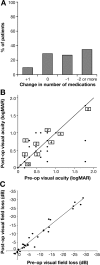A retrospective analysis of long-term outcomes following a single episode of transscleral cyclodiode laser treatment in patients with glaucoma
- PMID: 23833142
- PMCID: PMC3703569
- DOI: 10.1136/bmjopen-2013-002793
A retrospective analysis of long-term outcomes following a single episode of transscleral cyclodiode laser treatment in patients with glaucoma
Abstract
Objectives: To investigate the efficacy of a single cyclodiode laser photocoagulation treatment for refractory glaucoma and its effect on visual outcome in patients with good visual potential as well as to evaluate possible predictive factors in establishing optimal treatment parameters.
Design: Retrospective observational study.
Setting: Tertiary referral centre.
Participants: The notes of 87 patients with refractory glaucoma who underwent cyclodiode photocoagulation as a first surgical intervention over a 7-year period.
Main outcome measures: Maintenance of intraocular pressure (IOP) reduction, number of medications and visual acuity outcomes post-treatment.
Results: The mean IOP after a single treatment decreased from 39.5±1.3 to 17.8±1.5 mm Hg after a 6-week follow-up period (p<0.0001). This reduction in IOP was maintained over a 3-year period. Here, 61.5% of patients were able to reduce the number of medications used, with mean reduction from 2.6 to 1.5 medications (p<0.05). The mean initial visual field loss prior to treatment was 8.74 dB and at 6 months post-treatment was measured at 9.06 dB (p>0.05), suggesting no significant overall change. Visual acuity remained unchanged or improved for 83.6% of patients (p>0.05) with relatively good visual potential (average vision preoperatively was 0.57 logMAR). Hypotony occurred in 5.3% of patients. No patients required enucleation or evisceration.
Conclusions: A single session of cyclodiode laser therapy was associated with significant IOP reduction in a majority of patients with refractory glaucoma. The majority were able to maintain the IOP reduction over a 3-year period without the need for a further surgical intervention. Additionally, over 80% of the patients in our study were able to maintain their baseline visual acuity. These results support the view that a single cyclodiode treatment can be sufficient in achieving long-term IOP control and may be considered in eyes with relatively good visual potential.
Keywords: OPHTHALMOLOGY.
Figures




Similar articles
-
Contact Transscleral Cyclodiode Laser Treatment for Refractory Glaucoma After Penetrating Keratoplasty: Retrospective Long-term Outcomes.J Glaucoma. 2019 May;28(5):440-446. doi: 10.1097/IJG.0000000000001205. J Glaucoma. 2019. PMID: 30720572
-
Cyclodiode photocoagulation for refractory glaucoma after penetrating keratoplasty.Ophthalmology. 2001 Nov;108(11):1986-91. doi: 10.1016/s0161-6420(01)00767-9. Ophthalmology. 2001. PMID: 11713066
-
A two centre study of the dose-response relation for transscleral diode laser cyclophotocoagulation in refractory glaucoma.Br J Ophthalmol. 2003 Oct;87(10):1252-7. doi: 10.1136/bjo.87.10.1252. Br J Ophthalmol. 2003. PMID: 14507761 Free PMC article.
-
Cyclodestructive procedures for refractory glaucoma.Cochrane Database Syst Rev. 2019 Mar 10;3(3):CD012223. doi: 10.1002/14651858.CD012223.pub2. Cochrane Database Syst Rev. 2019. PMID: 30852841 Free PMC article.
-
[IOP spikes following contact transscleral diode laser cyclophotocoagulation].Arch Soc Esp Oftalmol. 2004 Mar;79(3):105-9. doi: 10.4321/s0365-66912004000300003. Arch Soc Esp Oftalmol. 2004. PMID: 15045651 Review. Spanish.
Cited by
-
Pigmented lesion in the anterior chamber angle following multiple trans-scleral diode laser photocoagulation for congenital glaucoma.Am J Ophthalmol Case Rep. 2018 Nov 14;13:32-33. doi: 10.1016/j.ajoc.2018.11.011. eCollection 2019 Mar. Am J Ophthalmol Case Rep. 2018. PMID: 30511031 Free PMC article.
-
Efficacy of 180° Cyclodiode Transscleral Photocoagulation for Refractory Glaucoma.Turk J Ophthalmol. 2018 Dec 27;48(6):299-303. doi: 10.4274/tjo.18559. Turk J Ophthalmol. 2018. PMID: 30605936 Free PMC article.
-
One-year outcome of low dose laser cyclophotocoagulation for capsular tension ring-induced malignant glaucoma: A case report.Medicine (Baltimore). 2020 Feb;99(6):e18836. doi: 10.1097/MD.0000000000018836. Medicine (Baltimore). 2020. PMID: 32028394 Free PMC article.
-
Transscleral Diode Laser Cyclophotocoagulation: A Comparison of Slow Coagulation and Standard Coagulation Techniques.Ophthalmol Glaucoma. 2018 Sep-Oct;1(2):115-122. doi: 10.1016/j.ogla.2018.08.007. Epub 2018 Aug 25. Ophthalmol Glaucoma. 2018. PMID: 32632402 Free PMC article.
-
Comparing the efficacy of trabeculectomy and diode laser cyclophotocoagulation in primary open-angle glaucoma.Int Ophthalmol. 2019 Nov;39(11):2485-2496. doi: 10.1007/s10792-019-01093-w. Epub 2019 Mar 4. Int Ophthalmol. 2019. PMID: 30830546 Clinical Trial.
References
-
- Hennis HL, Stewart WC. Semiconductor diode laser transscleral cyclophotocoagulation in patients with glaucoma. Am J Ophthalmol 1992;113:81–5 - PubMed
-
- Hawkins TA, Stewart WC. One-year results of semiconductor transscleral cyclophotocoagulation in patients with glaucoma. Arch Ophthalmol 1993;111:488–91 - PubMed
-
- Brancato R, Carassa RG, Bettin P. Contact transscleral cyclophotocoagulation with diode laser in refractory glaucoma. Eur J Ophthalmol 1995;5:32–9 - PubMed
-
- Threlkeld AB, Johnson MH. Contact transscleral diode cyclophotocoagulation for refractory glaucoma. J Glaucoma 1999;8:3–7 - PubMed
-
- Egbert PR, Fiadoyor S, Budenz DL. Diode laser transscleral cyclophotocoagulation as a primary surgical treatment for primary open angle glaucoma. Arch Ophthalmol 2001;119:345–50 - PubMed
LinkOut - more resources
Full Text Sources
Other Literature Sources
Miscellaneous
